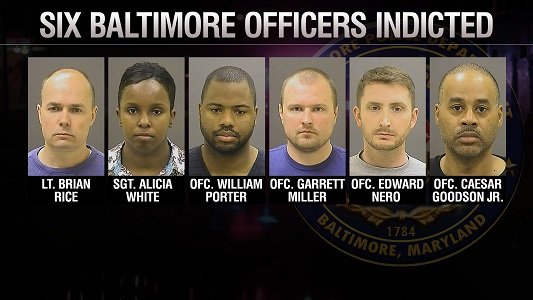(CNN) — Baltimore police Officer William Porter said Monday that Caesar Goodson had custody of Freddie Gray while Gray was inside the police wagon, and therefore was responsible for him.
Goodson is the police wagon driver on trial in connection with the arrest and death of Gray.
“You previously testified that whoever has custody of the prisoner is responsible for them. Who had custody of him at this time?” prosecutor Michael Schatzow asked Porter after multiple objections by Goodson’s defense attorneys.
Porter replied, “the wagon operator,” and identified Goodson.
Gray died after suffering a spinal injury during an arrest in April 2015. The death of Gray ignited a wave of protests as debate surged nationwide over whether police use excessive force, particularly against African-Americans.
Prosecutors have said that Gray complained of having trouble breathing and asked for medical help as he was driven in a police van. When he arrived at a police substation, he was unconscious. A week later, Gray died at a hospital from a spinal injury.
Porter was the first of the six officers to face a trial in the April 2015 death of Gray. Prosecutors went to great lengths to compel Porter to testify at his fellow officers’ trials with immunity, meaning his testimony cannot be used to incriminate him. His own trial ended in a mistrial in December and he is scheduled to be retried in September.
Gray was placed inside Goodson’s police wagon after being detained and arrested by three other Baltimore police officers. Porter responded to a call for assistance from Goodson at a later stop, but did not ask why Goodson was requesting help, according to his testimony.
Goodson opened the back doors of the police wagon and Porter said he saw Gray lying face down on the van floor with his feet facing the back of the wagon. After Gray asked Porter to “help him up,” Porter assisted Gray to the bench of the wagon and left him there sitting with his hands cuffed behind his back, Porter said.
Under cross-examination, Porter was asked by defense attorney Andy Graham to demonstrate how he assisted Gray onto the bench inside the van. Porter came off the stand, knelt and showed how he came up behind Gray, lifted him by putting his hands around him and raised Gray against his own body.
Porter said that there was “no possible way [he] could lift a 150-pound man and place him on the bench in such a confined space.” Porter said Gray assisted by pushing off the ground with his legs toward the bench.
Porter testified that there was no blood or lacerations on Gray that were visible to him and that Gray was breathing normally at the time. Nothing suggested to him that Gray needed immediate medical attention, despite Gray answering “yes” when Porter asked him whether he needed to go to the hospital, Porter testified.
When asked whether Gray was in a seat belt, Porter testified that he did not see anyone belt him. When asked whether he had the opportunity to belt him, Porter paused and said, “I guess so.”
Porter said he knew Gray prior to his arrest on April 12, 2015, and had “seen him multiple times in the neighborhood.” Porter said they had a “mutual respect” for each other.
Porter was the 12th witness called by the prosecution in the case against the wagon driver. Prosecutors say Gray suffered a fatal spinal injury because Goodson took him on a “rough ride.”
Goodson bears the “ultimate responsibility” for the fate of his prisoner, Schatzow said in his opening arguments last week. Gray was not wearing a seat belt when he was being transported.
A “rough ride” is a reputed police tactic reserved for particularly resistant suspects.
But Andrew Graham, Goodson’s attorney, told the court his client was a good officer who followed department procedure.
Evidence of a rough ride by Goodson does not exist, Graham argued. Gray’s injuries were caused in part by his own agitation and thrashing around in the van, the attorney said.
Prosecutors on Monday also called Dr. Morris Soriano, a board-certified neurosurgeon, as an expert witness. Soriano said that he believed with a “reasonable degree of medical certainty” that Gray would never have sustained the injuries he suffered if he was seat belted. “There’s no question he would have benefited from prompt medical attention,” Soriano testified, noting that the injuries Gray sustained would not have prevented him from communicating with the officers.
Goodson faces the most serious charges in the case, including second-degree depraved-heart murder, second-degree assault, misconduct in office, involuntary manslaughter, manslaughter by vehicles (gross negligence), manslaughter by vehicle (criminal negligence) and reckless endangerment.
Last Monday, the officer elected for a bench trial, meaning his fate will be decided by the same judge who acquitted Edward Nero, another Baltimore officer, last month on charges related to Gray’s death.
CNN’s Eliott C. McLaughlin, Aaron Cooper and Ray Sanchez contributed to this report.
